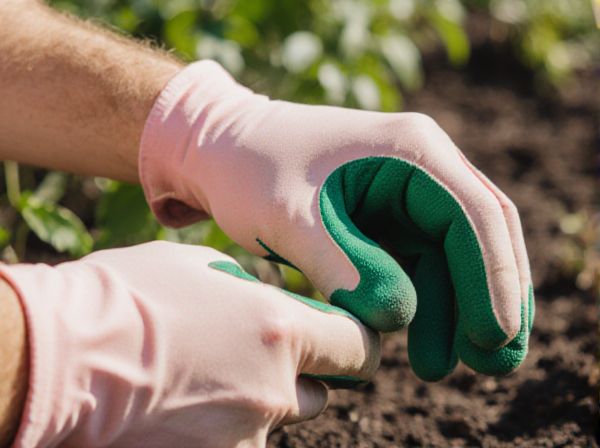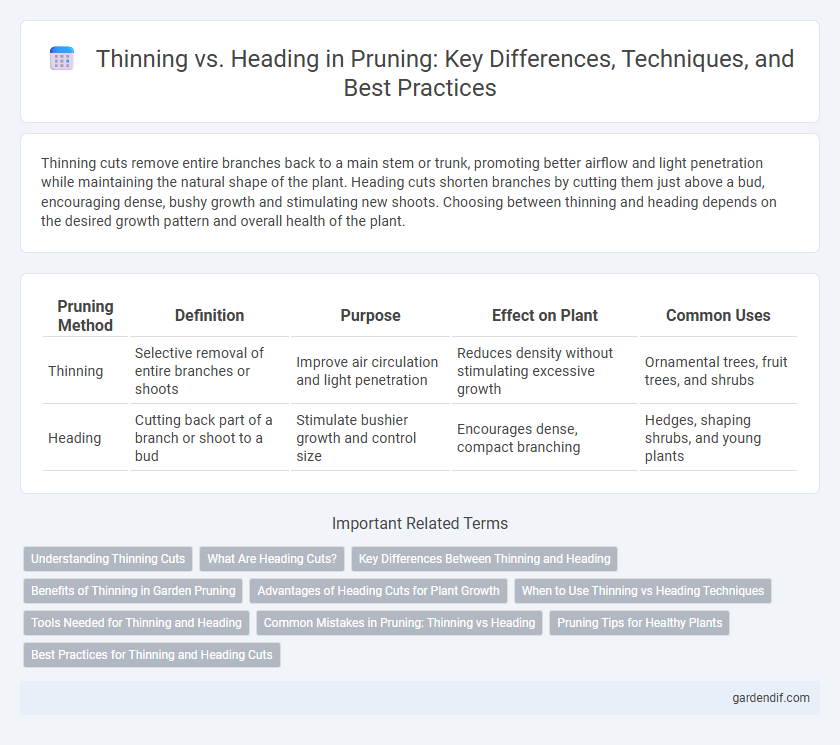
Thinning vs Heading Illustration
Thinning cuts remove entire branches back to a main stem or trunk, promoting better airflow and light penetration while maintaining the natural shape of the plant. Heading cuts shorten branches by cutting them just above a bud, encouraging dense, bushy growth and stimulating new shoots. Choosing between thinning and heading depends on the desired growth pattern and overall health of the plant.
Table of Comparison
| Pruning Method | Definition | Purpose | Effect on Plant | Common Uses |
|---|---|---|---|---|
| Thinning | Selective removal of entire branches or shoots | Improve air circulation and light penetration | Reduces density without stimulating excessive growth | Ornamental trees, fruit trees, and shrubs |
| Heading | Cutting back part of a branch or shoot to a bud | Stimulate bushier growth and control size | Encourages dense, compact branching | Hedges, shaping shrubs, and young plants |
Understanding Thinning Cuts
Thinning cuts selectively remove entire branches at their point of origin to open up the canopy, allowing light penetration and air circulation essential for plant health. Unlike heading cuts, which shorten branches and promote dense growth, thinning focuses on maintaining the natural shape and structure while reducing overcrowding. Effective thinning cuts enhance fruit quality and reduce disease risk by improving airflow and sunlight distribution throughout the plant.
What Are Heading Cuts?
Heading cuts involve cutting back a branch or stem to a bud, leaf, or lateral branch, stimulating dense new growth near the cut site. This pruning technique is commonly used to control plant size, encourage bushier growth, and shape the plant structure. Heading cuts differ from thinning cuts, which remove entire branches to open up the canopy and improve light penetration.
Key Differences Between Thinning and Heading
Thinning involves selectively removing entire branches or stems at their point of origin to improve light penetration and air circulation, whereas heading cuts back branches to a bud or lateral branch to encourage denser growth and branching. Thinning results in an open structure that reduces disease risk and supports natural growth patterns, while heading promotes compactness and increased foliage in a specific area. The key difference lies in thinning maintaining the plant's size and shape, whereas heading alters them by stimulating regrowth and bushiness.
Benefits of Thinning in Garden Pruning
Thinning in garden pruning enhances air circulation and light penetration, promoting healthier plant growth and reducing the risk of disease. It also maintains the natural shape of the plant, preventing overcrowding and encouraging the development of strong branches. This selective removal of branches minimizes stress and supports long-term plant vitality compared to heading cuts.
Advantages of Heading Cuts for Plant Growth
Heading cuts encourage vigorous lateral branching by removing portions of the terminal stems, stimulating the growth of new shoots closer to the cut. This technique promotes denser foliage, enhancing photosynthesis and overall plant vitality. Compared to thinning, heading cuts result in a more compact growth habit, making plants easier to shape and manage for optimal development.
When to Use Thinning vs Heading Techniques
Thinning is best used when the goal is to improve light penetration and air circulation by selectively removing entire branches, making it ideal during dormant seasons or early growth stages. Heading cuts are effective for stimulating dense new growth and controlling plant size, commonly applied during the active growing season on young or overgrown plants. Choosing between thinning and heading depends on whether the objective is to maintain natural shape and structure or to promote bushier, more compact growth.
Tools Needed for Thinning and Heading
Thinning requires precision tools such as bypass pruners, loppers, and hand saws to remove entire branches or stems at their origin, promoting airflow and light penetration. Heading relies on sharp pruning shears or secateurs to cut stems back to a bud or lateral branch, encouraging bushier growth. Selecting the right tool ensures clean cuts and minimizes plant stress during both thinning and heading.
Common Mistakes in Pruning: Thinning vs Heading
Common mistakes in pruning often involve confusing thinning with heading, which leads to improper growth responses in plants. Thinning removes entire branches at their point of origin, promoting natural structure and light penetration, while heading cuts shorten branches, stimulating dense, bushy growth that can cause overcrowding. Misapplication of these techniques results in weakened plant health and reduced fruit or flower production.
Pruning Tips for Healthy Plants
Thinning involves selectively removing entire branches to improve air circulation and light penetration, reducing the risk of disease and promoting balanced growth. Heading cuts shorten branches to encourage dense, bushier foliage but should be applied sparingly to avoid stress and weak new shoots. Proper timing and clean cuts are essential for both techniques to maintain plant health and vigor.
Best Practices for Thinning and Heading Cuts
Thinning cuts selectively remove entire branches to open the canopy, enhance air circulation, and allow sunlight penetration, promoting healthy growth and reducing disease risk in fruit trees and shrubs. Heading cuts shorten branches by cutting back to a bud or lateral branch, stimulating dense, bushy growth and controlling plant size but should be used sparingly to avoid excessive vigor and overcrowding. Best practices for thinning involve targeting crowded or crossing branches and making clean cuts at the branch collar, while heading should focus on maintaining natural plant shape and encouraging balanced growth.
Thinning vs Heading Infographic

 gardendif.com
gardendif.com